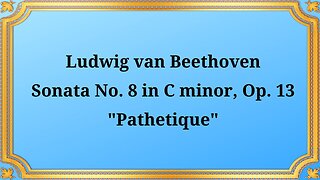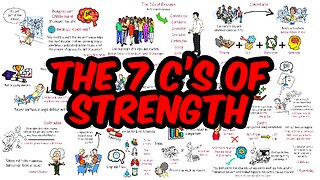Premium Only Content

Franz Joseph Haydn Horn Trio In E Flat
#ClassicalMusic #Haydn #HornTrio #EFlatMajor #ChamberMusic #ClassicalComposer #MusicHistory #MusicalAnalysis #ClassicalEra #InstrumentalComposition
Publication date 1951
Franz Koch horn, Walter Schneiderhan violin, Nikolas Huebner, cello
The world of classical music is adorned with numerous masterpieces, and among them stands the remarkable "Horn Trio in E Flat" composed by Franz Joseph Haydn.
Written in 1760, Haydn's Horn Trio in E Flat belongs to the early period of Haydn's career. During this time, Haydn served as a court musician for the Esterházy family, where he had the opportunity to experiment and develop his musical style. The trio was composed for the natural horn, violin, and piano, reflecting the instrumentation popular during the Classical era.
Haydn's Horn Trio follows the traditional three-movement structure commonly found in chamber music of the time.
1. Allegro: The trio begins with a lively and energetic Allegro movement, showcasing Haydn's skill in crafting engaging melodies and vibrant harmonies. The natural horn takes center stage, providing a distinctive and rich sound that is characteristic of the piece.
2. Andante: The second movement shifts to a slower tempo, offering a serene and lyrical atmosphere. The violin and piano engage in a beautiful dialogue, with the natural horn occasionally joining in to add color and depth to the musical texture. This movement highlights Haydn's ability to create expressive melodies and evoke a sense of emotional depth.
3. Finale: The trio concludes with a spirited and playful Finale. This movement showcases Haydn's mastery of rhythmic interplay and thematic development. The lively exchanges between the three instruments create a sense of joy and excitement, leading to a delightful and satisfying conclusion.
Haydn's Horn Trio in E Flat exhibits a rich tapestry of musical elements that contribute to its enduring appeal. These include:
Haydn's gift for crafting memorable melodies is evident throughout the trio. Each instrument has its moments to shine, with the natural horn's warm and resonant tones blending harmoniously with the violin and piano.
Haydn skillfully explores various harmonic progressions, incorporating unexpected chord changes and modulations. This harmonic adventurousness adds depth and complexity to the piece, keeping the listener engaged and intrigued.
Haydn adeptly manipulates the textures in the trio, alternating between moments of lush ensemble playing and intimate solo passages. This creates a dynamic interplay between the instruments and adds layers of richness to the overall musical experience.
Haydn employs a range of expressive techniques, such as ornamentation, dynamic contrasts, and expressive phrasing, to bring out the emotional depth of the composition. These techniques enhance the communication of the musical ideas and evoke a wide range of emotions in the listener.
Conclusion:
Franz Joseph Haydn's Horn Trio in E Flat stands as a testament to his genius as a composer and his significant contributions to chamber music. Its historical context, well-crafted structure, and masterful use of musical elements make it an enduring masterpiece. The trio continues to captivate audiences with its melodic beauty, harmonic exploration, and expressive qualities, reminding us of the timeless allure of classical music and Haydn's exceptional talent.
You have the opportunity to support the channel https://destream.net/live/RadSiarAl/donate
-
 18:26
18:26
Classical music_Music Inspiration
1 month agoLudwig van Beethoven Piano Sonata No. 8 in C minor, Op. 13 "Pathétique"
591 -
 12:48
12:48
Degenerate Jay
15 hours ago $1.17 earnedUbisoft Hates Game Preservation
15.6K5 -
 9:33
9:33
The Art of Improvement
21 hours ago $1.99 earnedHow to Bounce Back from Hard Times
17.9K4 -
 4:53
4:53
The Official Steve Harvey
1 day ago $1.34 earnedNo Such Thing as Luck — Just God’s Grace
16.9K3 -
 6:16
6:16
GBGunsRumble
21 hours agoGBGuns @ Alabama Arsenal Czech Weapons CSV-9
13.5K -
 9:06
9:06
MattMorseTV
1 day ago $14.05 earnedTrump wants to END THE FED.
66.6K108 -
 2:05:18
2:05:18
MG Show
20 hours agoBreaking: Ukrainian Whistleblower Letter to DNI Gabbard Exposes Biden Corruption
26.9K19 -
 LIVE
LIVE
Biscotti-B23
3 hours ago $2.14 earned🔴 LIVE SEASON 12 🔥 TAMAKI AMAJIKI IS INSANE & NEW ENDEAVOR QUIRK SET 💥 MY HERO ULTRA RUMBLE
139 watching -
 7:13:56
7:13:56
B2ZGaming
8 hours agoPlay All The Games?! | B2Z Gaming
12.8K -
 2:17:23
2:17:23
Side Scrollers Podcast
22 hours agoIronmouse/Vshojo SCANDAL, Stripe DE-BANKING “Wrong Think”, RIP Theo | Side Scrollers
37.7K1